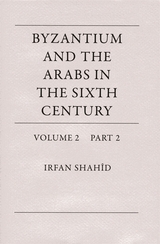8 books about Sixth Century

Byzantium and the Arabs in the Sixth Century
Irfan Shahîd
Harvard University Press, 1995
Byzantium and the Arabs in the Sixth Century, Volume 2, Part 1: Toponymy, Monuments, Historical Geography, and Frontier Studies is a topical study of the military, religious, and civil structures of the Ghassanids. Irfan Shahîd’s detailed study of Arab buildings of the sixth century illuminates how Byzantine provincial art and architecture were adopted and adapted by the federate Arabs for their own use. As monuments of Christian architecture, these federate structures constitute the missing link in the development of Arab architecture in the region between the earlier pagan (Nabataean and Palmyrene) and later Muslim (Umayyad) styles. Drawing from literary and material evidence, Shahîd argues that the Ghassanids were not nomadic, as traditionally believed, but thoroughly sedentary both in their roots and in the late Roman frontier zone they inherited.
[more]

Byzantium and the Arabs in the Sixth Century
Irfan Shahîd
Harvard University Press, 1995

Byzantium and the Arabs in the Sixth Century
Irfan Shahîd
Harvard University Press
Byzantium and the Arabs in the Sixth Century, Volume 2, Part 2: Economic, Social, and Cultural History reveals the history of a fully developed and unique Christian Arab culture, the Ghassanids, in the sixth century. Irfan Shahîd covers the Ghassanid economy, including trade routes and fairs, and reconstructs Ghassanid daily life, discussing topics as varied as music, food, medicine, the role of women, and horse racing. Shahîd examines cultural life, including descriptions of urbanization, Arabic script, chivalry, and poetry. Shahîd describes the society of the Ghassanids and their contributions to the cultural environment in Oriens during the sixth century and into the Umayyad caliphate.
[more]

Byzantium and the Arabs in the Sixth Century
Irfan Shahîd
Harvard University Press
Byzantium and the Arabs in the Sixth Century, Volume 1, Part 1: Political and Military History is devoted to the main Arabian tribes that were federates of the Byzantine Roman Empire. In the early sixth century, Constantinople shifted its Arab alliance from the Salīḥids to the Kindites and especially the Ghassanids, who came to dominate Arab-Byzantine relations through the reign of Heraclius. Arranged chronologically, this study, the first in-depth account of the Ghassanids since the nineteenth century, draws widely from original sources in Greek, Syriac, and Arabic. Irfan Shahîd traces in detail the vicissitudes of the relationship between the Romans and the Ghassanids, and argues for the Ghassanid’s extensive role in the defense of the Byzantine Empire in the east.
[more]

Byzantium and the Arabs in the Sixth Century
Irfan Shahîd
Harvard University Press
Byzantium and the Arabs in the Sixth Century, Volume 1, Part 2: Ecclesiastical History provides a chronologically ordered account of the involvement of the Ghassanids in ecclesiastical affairs in the eastern region of the Byzantine Empire. Tracing the role of Arab tribes both inside and outside the Roman limes, Irfan Shahîd documents how the Ghassanids, in particular, came to establish and develop a distinct non-Chalcedonian church hierarchy while remaining allies with the Chalcedonian emperors. Ghassanid phylarchs such as Mundir emerge not merely as loyal foederati but as devout Christians. Shahîd extensively and critically analyzes the Greek, Syriac, and Arabic sources, including many obscure or unfamiliar texts, to illuminate the religious landscape of the Arabs of the sixth century.
[more]

Byzantium and the Arabs in the Sixth Century
Irfan Shahîd
Harvard University Press
Byzantium and the Arabs in the Sixth Century, Volume 2, Part 1: Toponymy, Monuments, Historical Geography, and Frontier Studies is a topical study of the military, religious, and civil structures of the Ghassanids. Irfan Shahîd’s detailed study of Arab buildings of the sixth century illuminates how Byzantine provincial art and architecture were adopted and adapted by the federate Arabs for their own use. As monuments of Christian architecture, these federate structures constitute the missing link in the development of Arab architecture in the region between the earlier pagan (Nabataean and Palmyrene) and later Muslim (Umayyad) styles. Drawing from literary and material evidence, Shahîd argues that the Ghassanids were not nomadic, as traditionally believed, but thoroughly sedentary both in their roots and in the late Roman frontier zone they inherited.
[more]

Byzantium and the Arabs in the Sixth Century
Irfan Shahîd
Harvard University Press
Byzantium and the Arabs in the Sixth Century, Volume 2, Part 2: Economic, Social, and Cultural History reveals the history of a fully developed and unique Christian Arab culture, the Ghassanids, in the sixth century. Irfan Shahîd covers the Ghassanid economy, including trade routes and fairs, and reconstructs Ghassanid daily life, discussing topics as varied as music, food, medicine, the role of women, and horse racing. Shahîd examines cultural life, including descriptions of urbanization, Arabic script, chivalry, and poetry. Shahîd describes the society of the Ghassanids and their contributions to the cultural environment in Oriens during the sixth century and into the Umayyad caliphate.
[more]

Early Tamil Epigraphy from the Earliest Times to the Sixth Century A.D.
Iravatham Mahadevan
Harvard University Press
This book presents the earliest South Indian inscriptions (ca. second century B.C.E. to sixth century A.D.), written in Tamil in local derivations of the Ashokan Brahmi script. They are the earliest known Dravidian documents available and show some overlap with the early Cera and Pandya dynasties. Their language is Archaic Tamil, with a few borrowings from Prakrit and influences of old Kannada, both resulting from the early presence of northern Jainism. The widespread occurrence of pottery inscriptions indicates that the Tamil-Brahmi script had taken deep roots all over the countryside, leading to the cultured society visible in the classical Tamil poetry of the Cankam (Sangam) texts of the early centuries C.E. The work includes texts, transliteration, translation, detailed commentary, inscriptional glossary, and indexes.
[more]
READERS
Browse our collection.
PUBLISHERS
See BiblioVault's publisher services.
STUDENT SERVICES
Files for college accessibility offices.
UChicago Accessibility Resources
home | accessibility | search | about | contact us
BiblioVault ® 2001 - 2025
The University of Chicago Press









